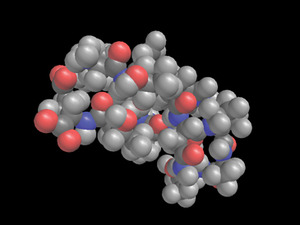How long before we see treatment?
Both Rosetta@home and Folding@home are making exciting findings in the field of medical research for a number of diseases, but incorporating that research into working therapies for diseases will be a long process.With regards to an HIV vaccine, Baker explains that "the next step is to test to see whether you [a human body] will make antibodies that block the virus when you’re injected with these proteins. We’ve shown the first few steps, but so far we haven’t got anything that actually leads to the creation of antibodies that block the virus. We’re not that many steps away, but we don’t really know what the problem is, and that’s true for the other disease-related work we’re doing as well."
Baker also points out that even when they’ve successfully created a vaccine, there still have to be large clinical trials to make sure that people don’t suffer from side effects. Baker is wary about predicting the timescale before we see treatments as a result of protein folding via distributed computing, but the other scientists with whom we spoke made vague predictions.
"I’d be surprised if we didn’t find a solution to Mad Cow Disease, the prion diseases and Alzheimer’s. I’d say it may take about ten years", says Scheraga, adding that the timescale will depend on how much money people are prepared to invest in research. Gruebele is more conservative, concurring that ten years is about right in terms of making discoveries in the lab, but the story won’t end there. After that, "it’s a long way to human treatment," says Gruebele, "so ten years is as fast as it could possibly move along. Just the drug or procedure certification processes in most countries take that long, even if you had the cure in hand right now."
 Pande agrees, pointing out that you can have an academic lab result that "looks promising, works in the test tube and maybe even works on tissue, but it’s not at the point where you can start giving it to human beings. For probably five years, it has to be optimised to be stable enough to be sold on the shelves as a drug. Then, for the next five years it has to get through clinical trials, so ten years is basically the shortest time that one could hope for."
Pande agrees, pointing out that you can have an academic lab result that "looks promising, works in the test tube and maybe even works on tissue, but it’s not at the point where you can start giving it to human beings. For probably five years, it has to be optimised to be stable enough to be sold on the shelves as a drug. Then, for the next five years it has to get through clinical trials, so ten years is basically the shortest time that one could hope for."Pande explains that this is "as drug design is very hard, it’s very easy to do more harm than good, and that’s one thing that we never want to see". However, Pande hopes to speed up the process of producing working treatments. "Our goal is to try to speed up the process to reach the point where we have something that could go in as a lead. I think we’re getting close to that, but we won’t stop at the leads we have now. We want to create a large array of different possible leads, so we’ll have some that will be useful as drugs if many don’t make it – there are all these things that could go wrong as you go further down the pipeline. Ten years is the shortest time, and my hope is that there will be something in 20 years."
It’s also worth noting that this is a comparatively new and incredibly complicated science. Baker points out that "almost all pharmaceuticals aren’t very high-tech in the way that they’re made. Many of them already exist, such as insulin. Insulin is a very important drug, but it’s something you have naturally in you and some people don’t have enough. We’re working on the next generation of drugs, which don’t exist in nature. The methods we’ve developed have really only existed for the last seven years, so it’s too soon to expect actual drugs on the market that are made using these methods".

MSI MPG Velox 100R Chassis Review
October 14 2021 | 15:04









Want to comment? Please log in.